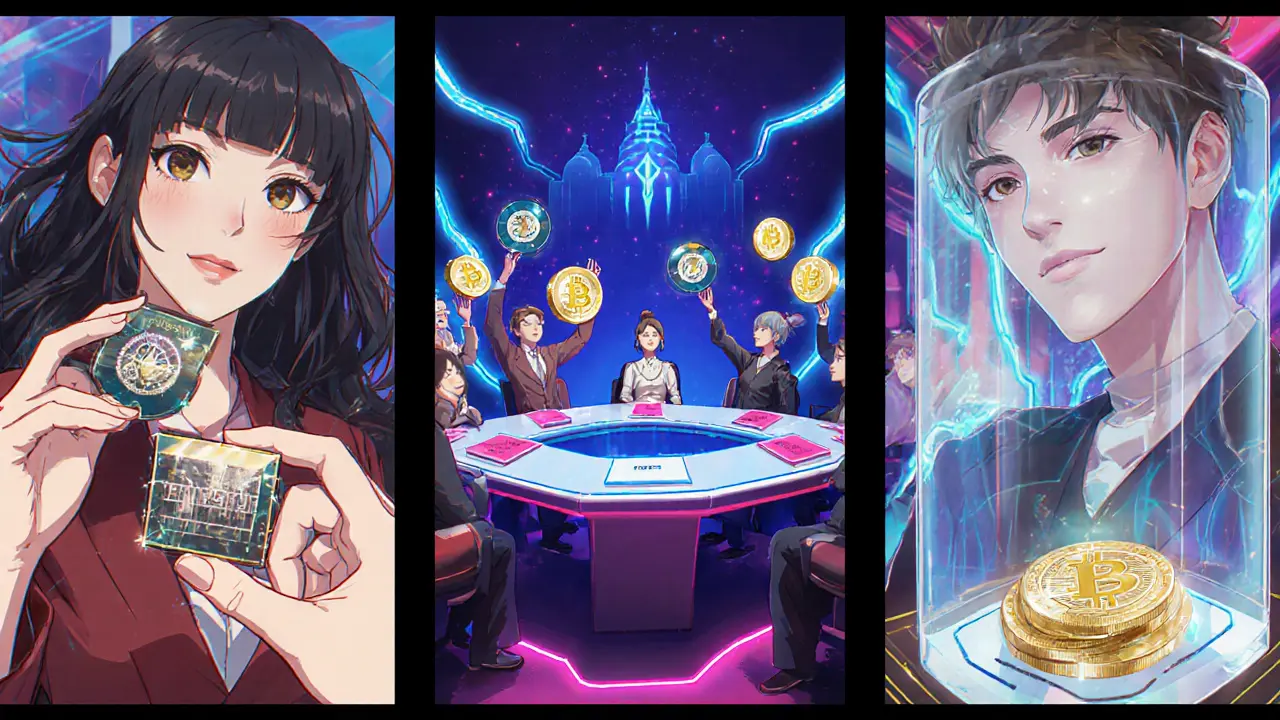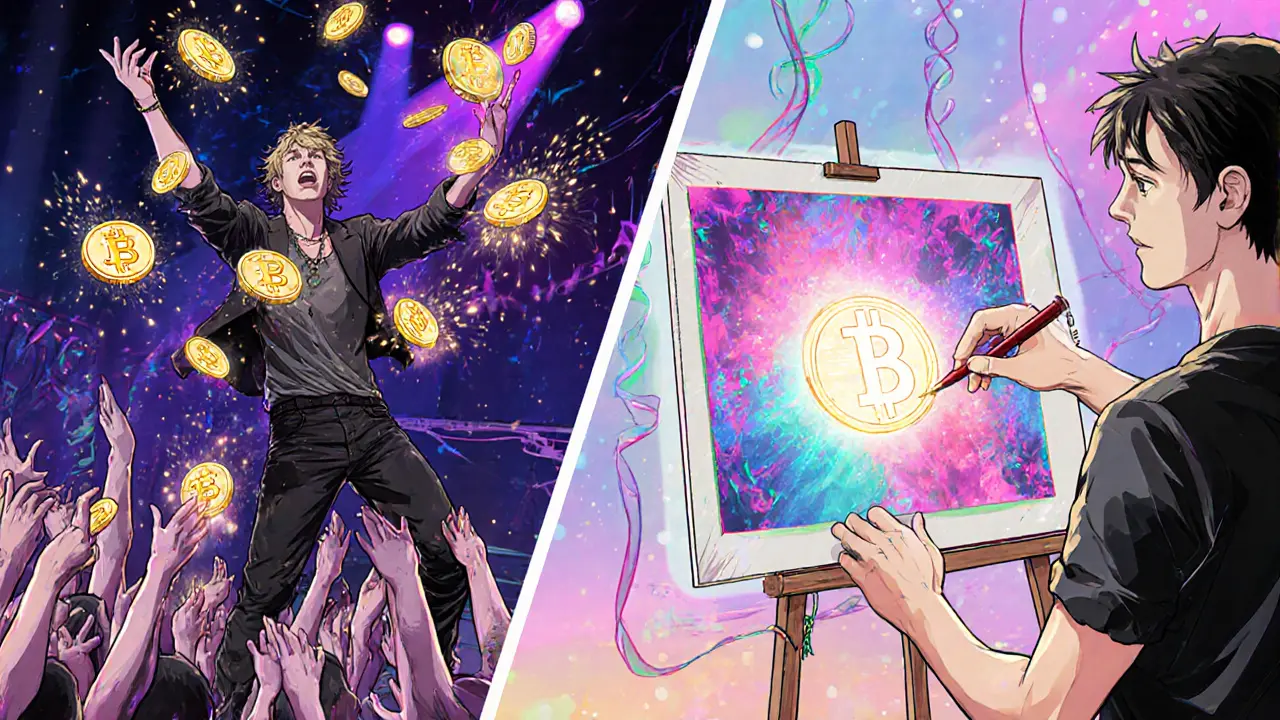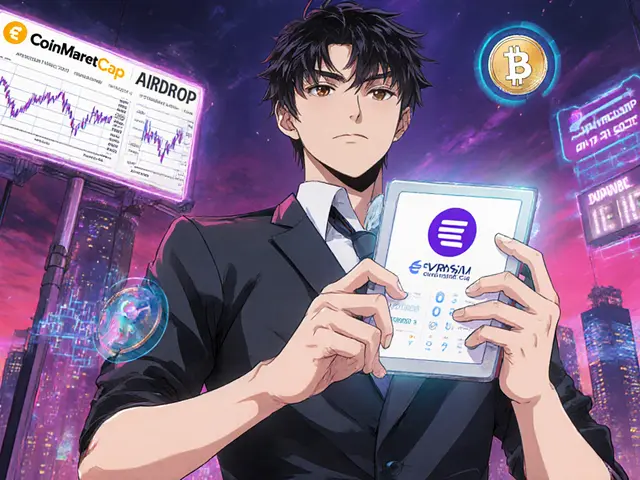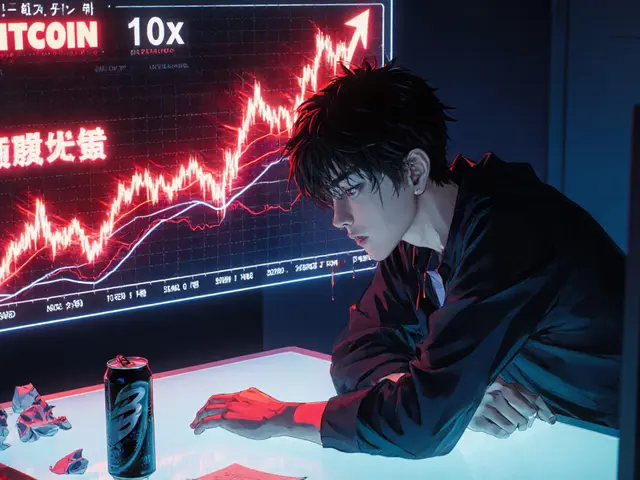Social Token vs NFT Decision Tool
Use this tool to compare your project needs against key features of social tokens and NFTs to determine which is more suitable for your goals.
Social Token
Ideal for access-based communities and ongoing utility.
NFT
Perfect for unique ownership and collectible assets.
Click "Compare & Recommend" to get your personalized recommendation.
Ever wonder why some creators hand out tiny currencies while others sell one‑of‑a‑kind digital art? The answer lies in the difference between social token vs NFT. One lets fans buy access; the other lets them own a piece of history. Below we break down what each asset is, how they work, where they shine, and which one might fit your project.
What a Social Token Actually Is
Social Token is a fungible digital asset that grants holders access to experiences, communities, or direct relationships with a creator or brand. Think of it as a community‑grade coin you can trade 1:1, just like any other cryptocurrency.
Social tokens fall into three groups:
- Personal/Creator tokens - issued by musicians, influencers, athletes, etc., to reward fans with exclusive content.
- Community tokens - used by groups or DAOs to manage membership, voting rights, and shared benefits.
- Platform tokens - built into a specific ecosystem to encourage activity and reward participants.
Because they’re fungible, a token’s value is set by an exchange rate (e.g., 1 token = $0.10) and can be swapped on standard crypto exchanges.
What an NFT Actually Is
Non‑Fungible Token (NFT) is a unique, indivisible digital token that proves ownership of a specific asset, such as artwork, music, or a virtual item. Each NFT lives under the ERC‑721 standard on Ethereum or compatible blockchains, giving it a distinct ID that can’t be duplicated.
Unlike a social token, an NFT can’t be exchanged on a 1:1 basis because every token carries its own metadata, rarity, and often a story that drives its price.
Core Technical Differences
At the code level, the separation is simple: ERC‑721 defines the non‑fungible standard for NFTs, while fungible tokens typically follow ERC‑20 or similar frameworks that support batch transfers and uniform pricing.
Because social tokens use a uniform contract, deployment costs are lower and scalability is higher. NFTs require individual metadata storage for each token, which raises gas fees and complexity.
Both assets sit on a blockchain, but the way they interact with wallets and marketplaces differs. Social tokens can be sent like any other coin, while NFTs need specialized marketplaces (e.g., OpenSea) to display their unique attributes.

Main Use Cases Where Each Shines
Social Token Use Cases
- Fan clubs that reward members with private streams, early‑ticket access, or merch discounts.
- DAOs that use tokens for voting on proposals and distributing treasury funds.
- Loyalty programs where points are tokenized for easy transfer and resale.
- Creators seeking steady income streams without relying on ad revenue.
NFT Use Cases
- Digital art collections where scarcity drives price (CryptoPunks, Bored Ape Yacht Club).
- In‑game items that players can own, trade, or rent across multiple games.
- Virtual real‑estate in metaverses like Decentraland.
- Music albums where each track is minted as an NFT, giving fans a provable ownership certificate.
Pros and Cons Checklist
Social Token pros and cons
- Pros
- Low entry cost - users can buy a single token for a few dollars.
- Clear exchange rate makes valuation easy for newcomers.
- Scalable for large communities; batch transfers keep gas cheap.
- Enables ongoing utility - creators can continuously add perks.
- Cons
- Value depends heavily on the creator’s fame; if interest wanes, price can drop sharply.
- Regulatory gray area - some jurisdictions may treat them as securities.
- Less “collectible” appeal for speculative traders.
NFT pros and cons
- Pros
- Scarcity creates strong price upside for rare pieces.
- Clear proof of ownership and provenance, valuable for artists.
- Highly tradable on dedicated marketplaces.
- Can embed royalties so creators earn on secondary sales.
- Cons
- High gas fees, especially on Ethereum mainnet.
- Requires understanding of metadata standards and smart contract nuances.
- Market can be volatile; hype‑driven bubbles are common.
Real‑World Examples to Put a Face on the Tech
When Sting launched a social token, fans could buy a token for $0.10 and unlock private livestreams, backstage passes, and early ticket sales. The token’s price stayed stable because the exchange rate was fixed, making it easy for casual fans to join.
Polish pop star Doda created a token that let holders receive daily video updates. The community grew quickly because the token acted like a subscription, but could be traded on secondary markets if someone wanted to leave.
In the NFT world, the CryptoPunks collection proved the power of scarcity. A single Punk has sold for over $20million, an outcome impossible for a fungible token.
The Shiba Inu community issued a community token that granted entry to a private Telegram group. If a member left, they could sell the token, providing liquidity for what would otherwise be a membership-only benefit.

How to Decide Which Asset Fits Your Goal
Use the following decision tree:
- Do you need *access* or *membership* benefits that can be granted to many people simultaneously? Yes → Social Token.
- Do you need *unique ownership* that can be displayed, traded as a collectible, or embed royalties? Yes → NFT.
- Is your budget tight and you need low‑cost transactions? Social Token wins.
- Are you building a brand that thrives on *scarcity* and *aesthetic value*? Pick NFT.
Many creators combine both: they sell an NFT artwork and simultaneously issue a social token that grants owners exclusive workshops or chat rooms. This hybrid model captures both the collector’s premium and the community’s ongoing engagement.
Side‑by‑Side Comparison Table
| Feature | Social Token | NFT |
|---|---|---|
| Fungibility | Yes - each token is identical | No - each token is unique |
| Primary Standard | ERC‑20 (or equivalent) | ERC‑721 (or ERC‑1155) |
| Typical Use Cases | Community access, DAO voting, loyalty points | Digital art, collectibles, virtual land |
| Transaction Cost (Ethereum) | Low - batch transfers cheap | Higher - each token requires separate gas |
| Valuation Method | Fixed exchange rate or market price per token | Rarity, creator reputation, market sentiment |
| Regulatory Risk | Potential securities classification | Generally treated as property, but still evolving |
| Scalability | High - suitable for thousands of holders | Limited - niche high‑value markets |
Frequently Asked Questions
Can I turn a social token into an NFT?
Yes. Some platforms let you “wrap” a fungible token into an NFT that represents a specific batch or a special edition, but the reverse is less common because NFTs are designed to stay unique.
Do I need to be a developer to launch a social token?
No. Many no‑code services (e.g., Roll, Coinvise) provide templates that handle the smart‑contract deployment, so creators can focus on community building.
Which blockchain is best for NFTs right now?
Ethereum remains the dominant ecosystem because of its mature marketplaces, but cheaper alternatives like Polygon, Solana, and Flow are gaining traction for lower fees.
Are social tokens taxable?
Tax treatment varies by jurisdiction. In many countries they are treated as income when received and capital gains when sold. Consulting a tax professional is advisable.
What risks should I watch out for?
For social tokens, watch regulatory scrutiny and token price volatility. For NFTs, watch high gas fees, market bubbles, and the need for secure storage (hardware wallets).







Eva Lee
August 8, 2025 AT 12:56The distinction between fungible social tokens and non‑fungible NFTs hinges on tokenomics and governance modules; social tokens leverage ERC‑20 utility standards for scalable liquidity and on‑chain voting, while NFTs rely on ERC‑721 metadata schemas for provenance tracking. Additionally, the vesting curves and reward mechanisms embedded in many community token contracts enable continuous engagement loops that NFTs simply cannot replicate.
Patrick MANCLIÈRE
August 8, 2025 AT 22:40When you break it down, social tokens are essentially a programmable currency for a community – they let you reward participation, grant access to exclusive channels, and even act as voting power in a DAO. NFTs, on the other hand, are unique parcels of data that certify ownership of a specific piece of content or virtual asset, which makes them perfect for collectors. Both have their place, but the choice really depends on whether you need repeatable utility or one‑off scarcity. If your project thrives on ongoing interaction, the token route is usually the smoother path.
Ciaran Byrne
August 9, 2025 AT 08:23Social tokens excel at community access; NFTs excel at scarcity.
Greer Pitts
August 9, 2025 AT 18:06Hey, that breakdown really helped me see the practical side of things. I love how you pointed out the continuous perks you can hook onto a token – it feels way more inclusive. Definitely going to share this with my guild.
Lurline Wiese
August 10, 2025 AT 03:50OMG, the drama of NFTs vs social tokens is like watching a reality TV showdown! One minute you’re sipping cheap coffee, the next you’re bidding on a pixelated cat.
Adarsh Menon
August 10, 2025 AT 13:33Oh great, another token hype train that’s going to crash soon.
Tyrone Tubero
August 10, 2025 AT 23:16Look, you need to understand the economics before you jump in. Simple math: if the tokenomics aren’t sound, the whole thing collapses.
Brooklyn O'Neill
August 11, 2025 AT 09:00I’m totally onboard with the idea of mixing both worlds. A hybrid could give creators the best of both utility and collectibility.
Matt Nguyen
August 11, 2025 AT 18:43It’s evident that mainstream narratives deliberately suppress the full potential of community‑driven tokenomics. By controlling the discourse, they keep the majority from accessing decentralized governance tools. This is why independent platforms matter.
Cynthia Rice
August 12, 2025 AT 04:26Both models have their own merit.
Scott McReynolds
August 12, 2025 AT 14:10Honestly, the future feels bright for creators who harness the synergy of social tokens and NFTs. When you give fans a token that unlocks daily perks, you build a living community that keeps producing value. Then, when you sprinkle limited‑edition NFTs into the mix, you reward the most dedicated members with tangible bragging rights. This dual approach creates a feedback loop: the token drives engagement, the NFT fuels aspiration. Over time, the community’s internal economy stabilizes, because the token’s liquidity feeds the NFT market and vice versa. Moreover, the data from token transactions can inform personalized experiences, making each interaction feel tailor‑made. Think about the analytics: you can see who buys, who redeems, and who holds, allowing creators to fine‑tune rewards. On the governance side, token holders can vote on new NFT drops, fostering a sense of co‑ownership. The psychological impact is huge – people love feeling both utility and exclusivity. As blockchain tech becomes cheaper, the barrier to minting both assets drops dramatically, opening doors for smaller creators. Artists can start with a modest token supply, then graduate to a curated NFT series once their audience matures. This progressive scaling mitigates risk while maximizing upside. In a world where attention is fragmented, giving your audience a reason to stay – both through constant access and rare collectibles – is a winning formula. So yes, the hybrid model isn’t just a buzzword; it’s an evolving strategy that aligns incentives across the board.
Bottom line: blend them, iterate, and watch the community thrive.
John Corey Turner
August 12, 2025 AT 23:53That hybrid vision is colorful and exciting! I’m curious how the royalty streams from NFTs could be redistributed via the token’s DAO treasury. Maybe we could even gamify the whole thing with quest‑based token rewards.
Kimberly Kempken
August 13, 2025 AT 09:36Both concepts are overrated hype machines that prey on naive fans. Social tokens promise community but deliver speculation, while NFTs glorify scarcity without real utility. Wake up, people.
Carthach Ó Maonaigh
August 13, 2025 AT 19:20Honestly, the whole token/NFT circus feels like a scam to me. Everyone’s trying to get rich quick off of digital hype.
Natalie Rawley
August 14, 2025 AT 05:03Everyone’s missing the obvious point: you don’t need a token or NFT to build a community. Real connection comes from genuine interaction, not blockchain gimmicks.
Twinkle Shop
August 14, 2025 AT 14:46From a cultural diffusion perspective, integrating tokenomics into creative ecosystems can democratize access to previously gatekept assets. By leveraging ERC‑20 standards for fungibility, creators can embed micro‑rewards that scale with audience growth. Concurrently, ERC‑721 NFTs serve as immutable provenance markers, cementing the historical narrative of a work. This bifurcated model aligns with both network effect theory and scarcity economics, creating a dual‑track value proposition. In practice, thoughtful design of token distribution curves and royalty splits can foster sustainable ecosystems beyond the hype cycle.
Jenise Williams-Green
August 15, 2025 AT 00:30What they don’t tell you is how quickly the market turns on you once the novelty fades. The moral of the story? Stay skeptical.
Kortney Williams
August 15, 2025 AT 10:13I think a hybrid approach offers a balanced path forward, combining the inclusive utility of tokens with the aspirational appeal of NFTs. It respects both the community’s need for access and the collector’s desire for uniqueness.
Laurie Kathiari
August 15, 2025 AT 19:56If you ignore the data showing declining NFT sales, you’re setting yourself up for disappointment. The metrics speak louder than the hype.